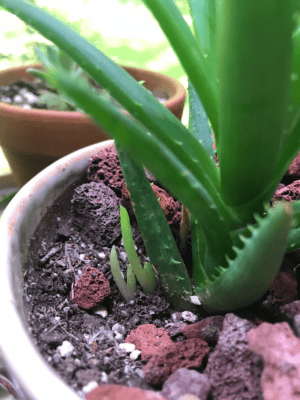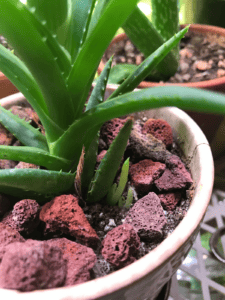This post contains affiliate links.
Propagating new succulents from offsets is, in my experience, the easiest way to grow new succulents and expand your succulent collection. If your succulents have grown some offsets (also called offshoots or pups), you may be wondering what you need to do with them. How do you remove them and plant them to grow new succulents?
If you want to propagate new succulents from offsets, cut or twist off the offsets from the main plant. Let them dry for 1-3 days to form a callus over the wound. Then plant it in a well-draining soil mix; it will produce roots and grow into a new plant.
Although propagating new succulents from offsets is fairly easy, there are a few other things you need to know that will help the process go a little smoother.

When to Propagate New Succulents From Offshoots
You can propagate from offshoots at any point of time, but the best time is during the growing season. This is usually in the late spring and the summer months, the warmer months of the year.
You will have more success propagating new succulents during these months since the conditions will be perfect for their growth.
However, it is possible to do it at other times of the year too if you give them the conditions they need for growth. This is where having an LED plant light comes in handy when you’re propagating succulents indoors.
If you don’t have enough light in your home, or if you’re growing plants indoors during the winter in Northern parts of the U.S.– a time of the year when daylight hours are short– you’ll likely need to provide additional lighting for your plants. If that is so, you might want to consider using this full spectrum LED light from Amazon.
There are a few types of succulents that have their growing season in cooler conditions, so it makes sense to know a little bit about the type of plant you are trying to propagate. Some examples of cooler-weather succulents are (some of) the Sempervivum which includes Hens and Chicks, and any Aeonium which includes plants like Aeonium Kiwi. Their growing seasons are in the spring and fall.
Supplies and Equipment You Will Need
🌵 Sharp knife or razor blade.
This is to remove the offsets from the main plant.
🌵 A pair of gardening gloves
You may need this to protect your hands from sap and dirt.
These ones from Amazon would work very well for this purpose.
🌵 New pot or planter
You will need a pot or planter for propagating your new succulents.
🌵 Fresh potting soil
You will need some fresh potting soil for your new succulents. You need soil that is well-draining such as a good succulent soil mix (or a mix made for both succulents and cacti). You can buy that locally or online.
If you’d like to mix your own soil for this, we have a guide that can help you along.
Amazon has this succulent soil mix that I like to use; Bonsai Jack Succulent and Cactus soil.
Another one I like to use is called Miracle-Gro Succulent potting mix, also from Amazon. Since this soil was a little too heavy for my plants, I amend it with perlite to make it drain quicker and it works out very well. I use this when I need something more economical.
How to Grow or Propagate Succulent Offsets

Step one:
Find a healthy plant with offsets (which are also called pups, or offshoots) and carefully cut them off from the main plant. You should use a clean, sharp knife or razor blade for this. (In some cases you may not need a knife, since some offsets can be removed by gently twisting them off of the main plant.)
If the offset is at the base of the mother plant and is in the soil you will need to gently cut through the soil between the mother plant and the offset, then carefully dig up the section of dirt around it to lift it out.
Step two:
If you had to cut the offset away from the main (mother) plant, it now has a fresh wound that needs to dry out before replanting. Let it dry for 1-3 days before planting it into a new pot. This allows the wound to form a callus.
Alternatively, you may remove the main plant from its pot and then cut off the offsets. In this case, let both the main plant and its offshoots dry out for 1-3 days to form a callus.
Note: Some people have had success with planting the offsets directly without having callus formed, but I have always followed this method.
Step Three:
You may find that the offsets already have roots growing, in this case, this makes it more likely for your propagation to be successful.
For this case, prepare a new pot with fresh succulent soil. Make a hole in the soil with your fingers and gently plant the offset into the soil, being careful to not damage its roots. Press the soil lightly around the offset so that it stands upright in the pot. If it doesn’t have roots, you should propagate this offset as you would a stem cutting.
If you want to learn how to propagate a stem cutting, you can read about that here.
Step Four:
Lightly water your new succulent plants when the soil is dry. When you are propagating new succulents, they need a little more water than established plants.
I find that misting them or lightly watering them every day or two helps them get established. Mist or water them just enough to wet the soil surface and just enough so that the soil is dry by the following day.
Note: You don’t want to overwater your new succulents, but you also want to water them more than you would for mature succulents.
Once these new succulents have become established you may decrease the watering schedule so that you only have to water them about once a week (or when the soil is dry) just as you would do for other mature succulents.
Step Five:
Keep your newly planted offsets out of direct sunlight. For indoor plants, you should keep them in the brightest part of your house but not in direct sunlight as they can be damaged from harsh or direct sun.
If your home doesn’t have enough light, you may consider supplementing with an LED plant light.
Why Does My Succulent Have Offsets, and Why Remove Them?
Some types of succulents spread naturally by putting out offsets; this is a sign that your plants are very healthy and that they want to spread. Having some offsets is fine and won’t cause any problems; in fact, it’s sometimes just what you want your plant to have.
For example, much of the appeal of growing hens and chicks is to have both the hen (the main plant) and the chicks (the offsets).
I believe that too many offsets can take away energy from the main plant, and removing these offsets will not only give you new plants to add to your collection but will also help keep the main plant healthy.
Offsets Form in Different Ways

Hens and Chicks is an example of one type of offset you will find — the main plant spreads by putting out runners with new babies (the offsets) growing at the end. These runners are underground, and the offsets grow roots.
There are also other succulents that grow offsets near the base of the main plant. These offsets appear to just spout out of the dirt close to the plant, but they are still attached.
For example, snake plants will grow what looks like small baby plants sprouting out of the ground near the mother plant. These offsets can be cut off and propagated into new snake plants.
There are other types of offsets that seem to grow right off of the main plant’s stem; these ones can be removed and propagated the same way you would a cutting. If you are interested in learning about how to propagate succulent cuttings, check out our article here.
Offsets can also be found growing on the leaves of the main plant. like they do with the mother of thousands, Kalanchoe daigremontiana.
Types of Succulents That Produce Offsets (Pups or Offshoots)
Not all succulents reproduce with offsets, but many of them do. A few examples are the aloes, hens and chicks, snake plants, sedums, and some cacti too. A few more examples are the Echeveria succulents and all the plants in the genus Sempervivum.
In the table below, monocarpic means that the main plant dies after blooming and sending out offsets.
| Succulent | Family | Genus | Propagation Type | Mono-carpic | Reference |
| Agave | Asparagaceae | Agave | Offsets are near the base of the main plant | Yes | NC Extension |
| Aloe | Asphodelaceae | Aloe | Offsets are near the base of the main plant | Yes | NC Extension |
| Crassula Succulents | Crassulaceae | Crassula | Offsets are near the base of the main plant | No | Wisconsin Horticulture, Division of Extension |
| Echeveria Succulents | Crassulaceae | Echeveria | Offsets are at the end of runners (stolons) | No | NC Extension |
| Haworthia succulents | Asphodelaceae | Haworthia | Offsets form near the main plant | No | Wisconsin Horticulture, Division of Extension |
| Lithops | Aizoaceae | Lithops | Offsets form near the main plant | No | Wisconsin Horticulture, Division of Extension |
| Mother of Thousands | Crassulaceae | Kalanchoe | Plantlets grow on the leaves | Yes | NC Extension |
| Sedum Succulents | Crassulaceae | Sedum | Offsets grow almost as runners with their own roots and spread by creeping | No | Penn State Extension |
| Sempervivum succulents | Crassulaceae | Sempervivum | Offsets are runners called long stolons | Yes | NC State Extension |
| Snake Plants | Asparagaceae | Dracaena | Offsets are near the base of the main plant | No | Penn State Extension |
This post was written for cactus-central.com and is not permitted to be used on other sites.
